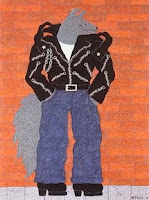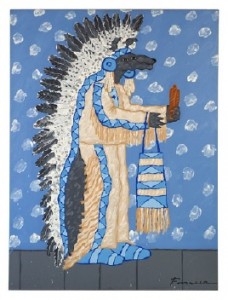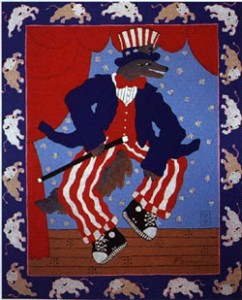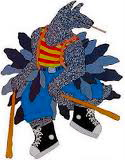 |
| Harry Fonseca, When Coyote Leaves The Reservation |
Coyote the trickster — generous and greedy, crafty and impulsive, clever and reckless — is not dead yet. Coyote is the great cosmic creator and the clumsy destroyer — as literary critic Franchot Ballinger puts it, “a force of multifarious creative energy.” Coyote is killed, chopped up, crushed, and destroyed, yet always comes back to life, sometimes wiser and sometimes not, just like the indigenous peoples of North America who created him. Coyote has the power to alter his appearance, says Ballinger, but nothing alters his personality — deceiving, foolish, lecherous, powerful. In Leslie Marmon Silko‘s Storyteller, we find a typical story: A whole bevy of coyotes, in order to steal the picnic baskets of the kachina dancers, make a coyote chain from the top of a cliff, each coyote holding the tail of another in its mouth. All goes well until one of the coyotes farts.
Coyote has become a powerful symbol for many contemporary Native Americans, expressing their heritage, their ability to survive, their own wryly observed foolishness, and the inimitable Indian sense of humor.
 |
| Harry Fonseca, Coyote Chief with Cigars |
Peter Blue Cloud is a Mohawk, born to the Turtle Clan in 1933, and raised on the reserve in Kahnawake, Quebec, where he lives today. He is the winner of the American Book Award, and is the author of numerous poetry collections, including Clans of Many Nations and Elderberry Flute Song: Contemporary Coyote Tales , from which the poem below is taken.
Growing up on the Kahnawake Reserve, Blue Cloud spoke only Mohawk at home; he was introduced to books in English by his grandfather. He began writing poems and songs as a teenager, and was first published in the journal Akwesasne Notes, where he became poetry editor in 1975. He has worked as an ironworker, logger, carpenter, and woodcutter. His poetry is noted for combining Native American myths with contemporary issues. “Blue Cloud’s poems are living proof that the power and beauty of the Old Way cannot be lost,” writes poet Gary Snyder. “Blue Cloud does nothing glamorous: he speaks from his own heart and life. He is a true poet, at home in all times, everywhere.” He is especially known for his use of the Coyote figure in his stories and poems. The following is his poem Coyote, Coyote Please Tell Me.
Coyote, Coyote, Please tell me
What is a shaman?A shaman I don’t know
anything about.
I’m a doctor, myself.
When I use medicine,
it’s between me,
my patient,
and the Creation.Coyote, Coyote, Please tell me
What is power?It is said that power
is the ability to start
your chainsaw
with one pull.Coyote, Coyote, Please tell me
What is magic?Magic is the first taste
of ripe strawberries and
magic is a child dancing
in a summer’s rain.Coyote, Coyote, Please tell me
Why is Creation?Creation is because I
went to sleep last night
with a full stomach,
and when I woke up
this morning,
everything was here.Coyote, Coyote, Please tell me
Who you belong to?According to the latest
survey, there are certain
persons who, in poetic
or scholarly guise,
have claimed me like
a conqueror’s prize.Let me just say
once and for all,
just to be done:
Coyote,
he belongs to none.
 |
| Harry Fonseca, Shuffle Off to Buffalo |
Artist Harry Fonseca was born in Sacramento, California, in 1946, and is of Nisenan Maidu, Hawaiian, and Portuguese heritage. Fonseca’s earliest pieces drew from his Maidu heritage — basketry designs, dance regalia, and participation as a traditional dancer. Further, the creation myth of his people, as recounted by his uncle, Henry Azbill, became the source of a major 1977 work, Creation Story, expressing in visual terms the mythic underpinnings of Maidu culture.
 |
| Harry Fonseca, Coyote Dancer |
His wildly popular Coyote series — begun in 1979, paused, and then revived, rather like Coyote himself — resituated its trickster protagonist into contemporary settings — leather-jacketed hoodlum, dancer in sneakers, cigar store Indian, entertainer dressed as Uncle Sam. The shapeshifting trickster glimpsed beneath conventional appearances became for Fonseca the image of the American Indian in contemporary society, as well as the image of himself as revelatory artist. Gary Snyder says that Fonseca’s “flower-like, bird-like bright dancing images of Coyote and Rose — often placed on the streets of our hard-edged urban world — are a promise like a knife: of sharp truths to come, of new ways to be. I love the wit and play of his art, and the depths of the myth it is founded on.”
Fonseca died in Albuquerque, New Mexico, in 2006, of a brain tumor. An interview with Fonseca can be found here. And the following is a poem he wrote, entitled, of course, Coyote:
Some say that Coyote first appeared on a raft
That Coyote created the world
That Coyote is very old the first one
That Coyote put the stars in the universe
That Coyote fucked up the planets
That Coyote is the giver and taker of life
That Coyote stole fire for the people
That Coyote can change the seasons.II
Some say that Coyote dances in a feather cape trimmed with flicker quills
That Coyote plays a flute and is the best dancer around
That Coyote has more clamshell and magnesite beads than you can imagine
That Coyote can make redbud burst into bloom by staring at it
That Coyote wanted to be a falling leaf and tried it
That Coyote was looking for figs and followed a male
That Coyote is a poet
That Coyote is a foolIII
Some say that Coyote is on the streets and in the alleys
That Coyote lives in L.A. and San Francisco and eats out of garbage cans
That Coyote talks to his asshole and usually takes its advice
That Coyote howls at the moon because it never stays the same
That Coyote doesn’t like change
That Coyote is changeIV
Some say that Coyote wears a black leather jacket and hightop tennis shoes
That Coyote thinks that Rose is a good singer
That Coyote eats frybread peanut butter and jelly
That Coyote will use you if you don’t watch out
That Coyote will teach you if you let him
That Coyote is very young the new one
That Coyote is a survivorSome say Coyote is a myth
Some say Coyote is realI say Coyote is
I say Coyote
I say Coyote

- Previous Post: Daniel Mirante
- Next Post: Why Dogs Do What They Do
- More Articles Related to: Books and Art, Indigenous Culture



Coyote is a trickster and a clown
Yet the most serious person you’ll find
Coyote is the smoking mirror
Where we look for personal beauty
And see our vanity staring at us
If coyote sees you being sorry for yourself
He’ll grab you and beat you up
Then take your spot
And start doing the same things you were doing
So you can see yourself
Coyote never follows
Yet he’s there with you at all times
The other day
I waited and waited for him at the airport
Right next to the arrivals gate
Then he yelled my name
All the way from the departures door
Laughing at me and my backward ways
Coyote comes dancing
And takes or gives me my comfort zone
With a big scalpel or a smile
Coyote is a space cadet, yet a genius
Even if to you talking backwards makes no sense
This was something that his third grade teacher
Couldn’t understand
Coyote is a jerk on the third day of dancing when I am starving
And he speaks of his breakfast coffee, steak and eggs
Coyotito stole my mate
And saved me form a certain heart pain
I went with Coyote to a winter sweat the other day
He insisted to uncle to please give us some warmth
While he was freezing we were melting
Once done
We were running for cover
While he jumped naked in the snow
Coyote speaks of being tired
Yet I have never seen him rest
I found him drinking cold lemonade in the jungle
As I was struggling to climb for dear life
And to breath some air
I saw him in the dessert
I saw him in the plains
I saw him right by the door in the tipi meeting
I see him all over at Sundance
I saw him in the hill
And If I am not careful
He’ll write for this me…
Ho. A Ho.
Love the poems!